MN691 Research: IOT in Logistics and Supply Chain Optimization
VerifiedAdded on 2021/12/22
|14
|4444
|35
Report
AI Summary
This report, prepared for the MN691 Research Methods and Project Design course, investigates the integration of the Internet of Things (IOT) in logistics and supply chain management, focusing on the optimization of refill shelves. It examines the challenges and opportunities presented by IOT, including the use of XBlock robots for automation. The report includes an abstract, introduction, problem domain analysis, and research questions, alongside a review of literature and project objectives. It delves into the requirements analysis and specifications, discussing the potential of IOT to improve inventory management, real-time tracking, and warehouse operations. The research also explores the use of collaborative mobile robots and the role of cloud computing in enhancing robotics. The report concludes with a discussion of limitations and future research directions, emphasizing the potential of IOT to transform supply chain processes and improve operational efficiency.
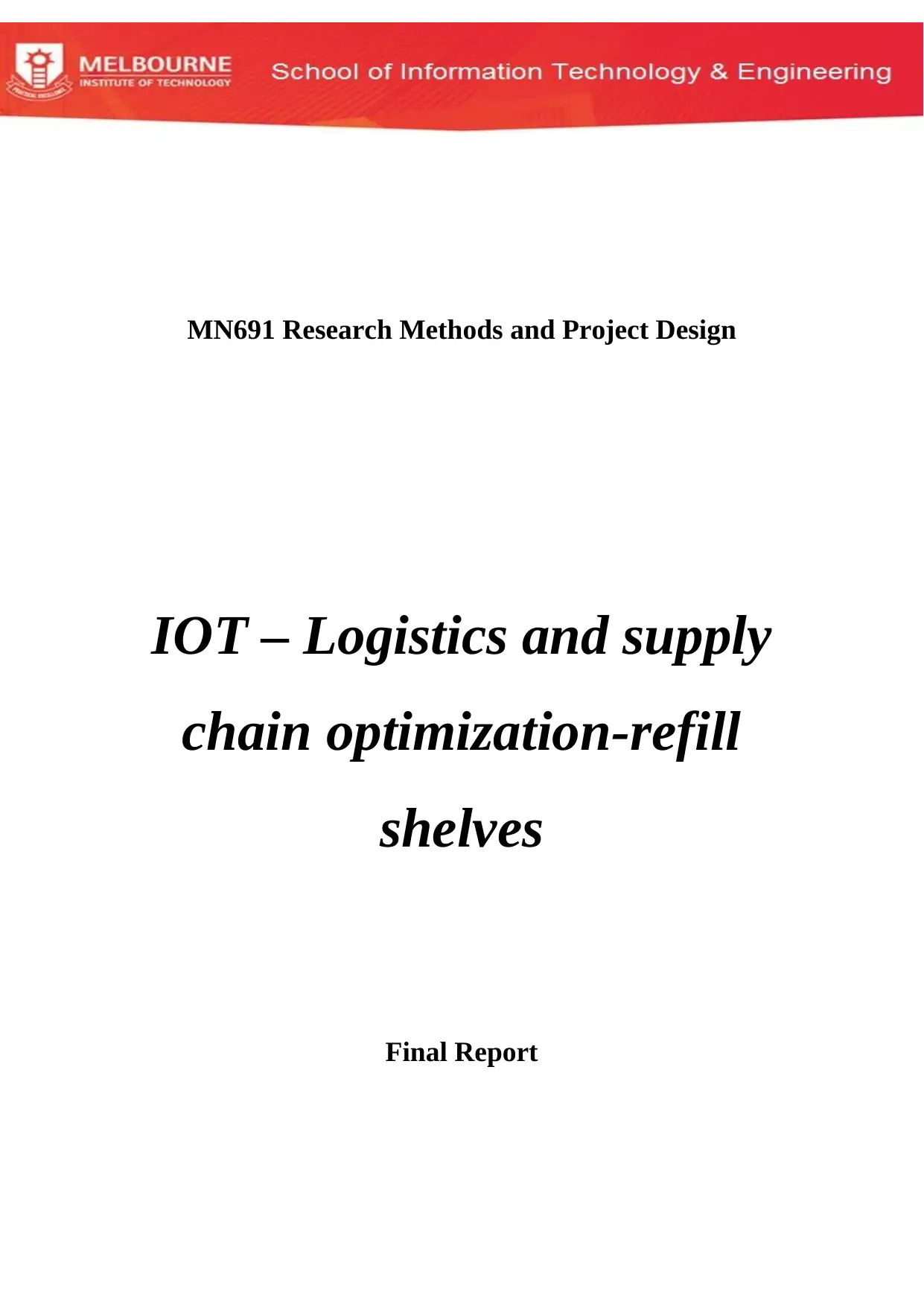
MN691 Research Methods and Project Design
IOT – Logistics and supply
chain optimization-refill
shelves
Final Report
IOT – Logistics and supply
chain optimization-refill
shelves
Final Report
Paraphrase This Document
Need a fresh take? Get an instant paraphrase of this document with our AI Paraphraser
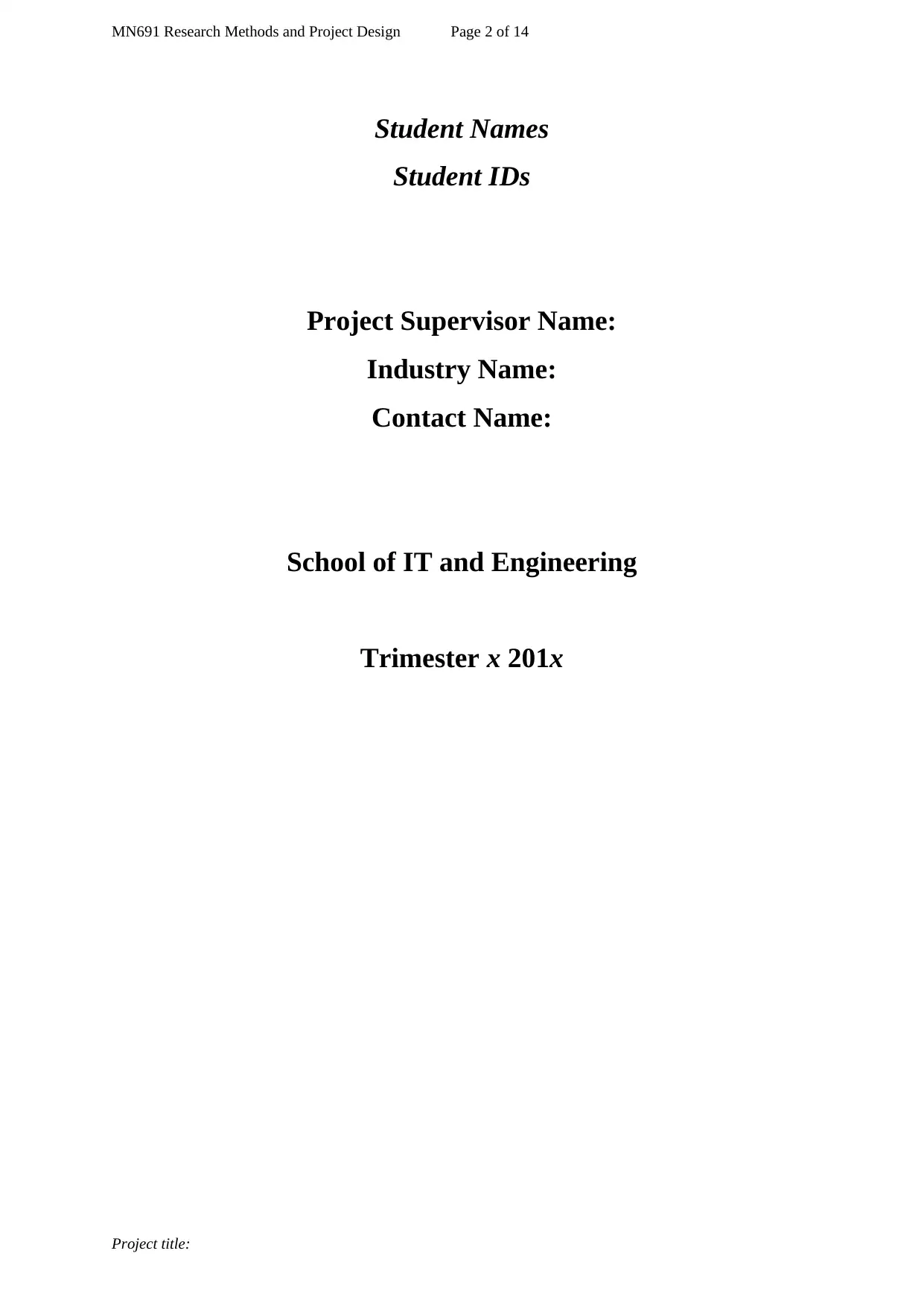
MN691 Research Methods and Project Design Page 2 of 14
Student Names
Student IDs
Project Supervisor Name:
Industry Name:
Contact Name:
School of IT and Engineering
Trimester x 201x
Project title:
Student Names
Student IDs
Project Supervisor Name:
Industry Name:
Contact Name:
School of IT and Engineering
Trimester x 201x
Project title:
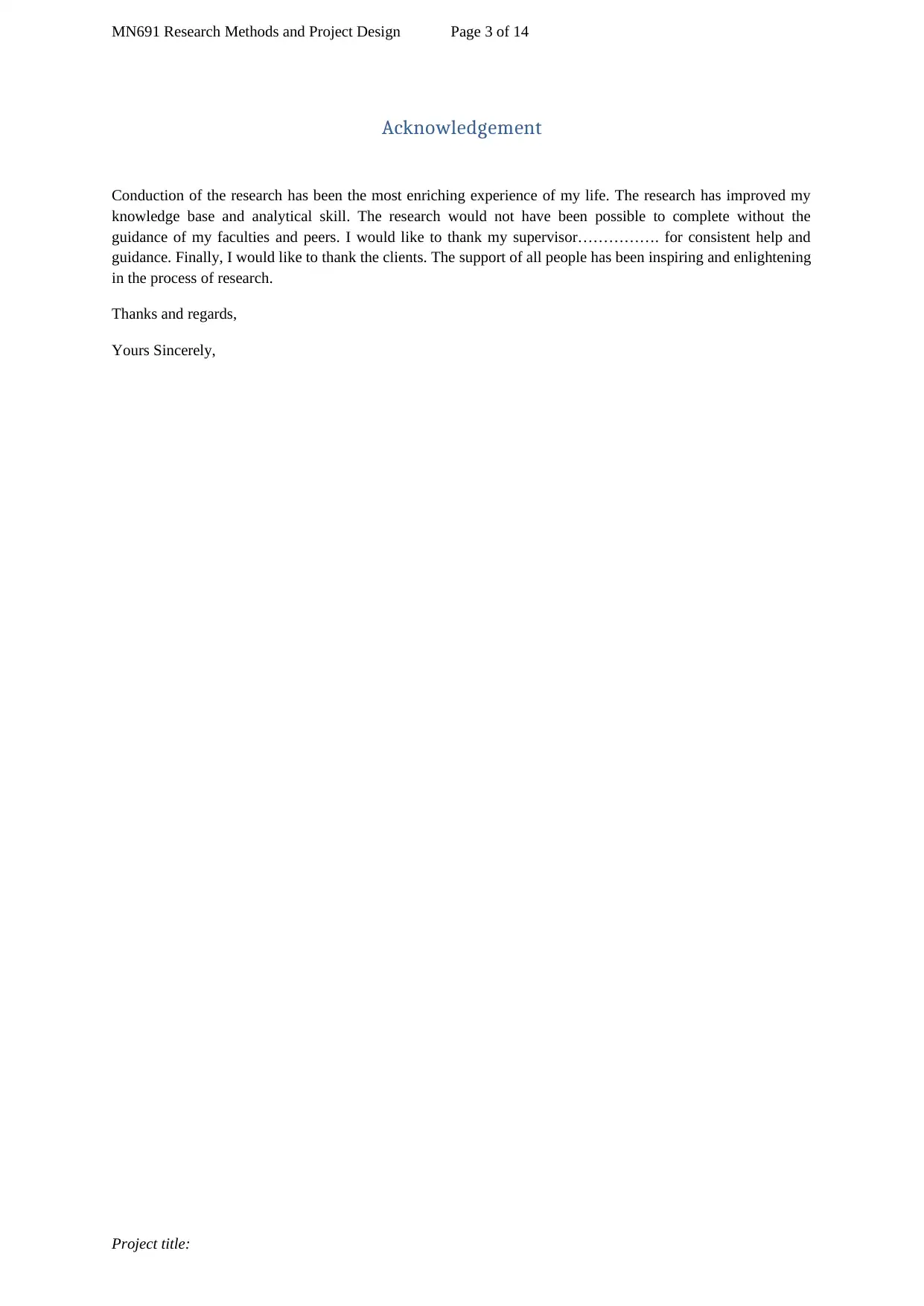
MN691 Research Methods and Project Design Page 3 of 14
Acknowledgement
Conduction of the research has been the most enriching experience of my life. The research has improved my
knowledge base and analytical skill. The research would not have been possible to complete without the
guidance of my faculties and peers. I would like to thank my supervisor……………. for consistent help and
guidance. Finally, I would like to thank the clients. The support of all people has been inspiring and enlightening
in the process of research.
Thanks and regards,
Yours Sincerely,
Project title:
Acknowledgement
Conduction of the research has been the most enriching experience of my life. The research has improved my
knowledge base and analytical skill. The research would not have been possible to complete without the
guidance of my faculties and peers. I would like to thank my supervisor……………. for consistent help and
guidance. Finally, I would like to thank the clients. The support of all people has been inspiring and enlightening
in the process of research.
Thanks and regards,
Yours Sincerely,
Project title:
⊘ This is a preview!⊘
Do you want full access?
Subscribe today to unlock all pages.

Trusted by 1+ million students worldwide
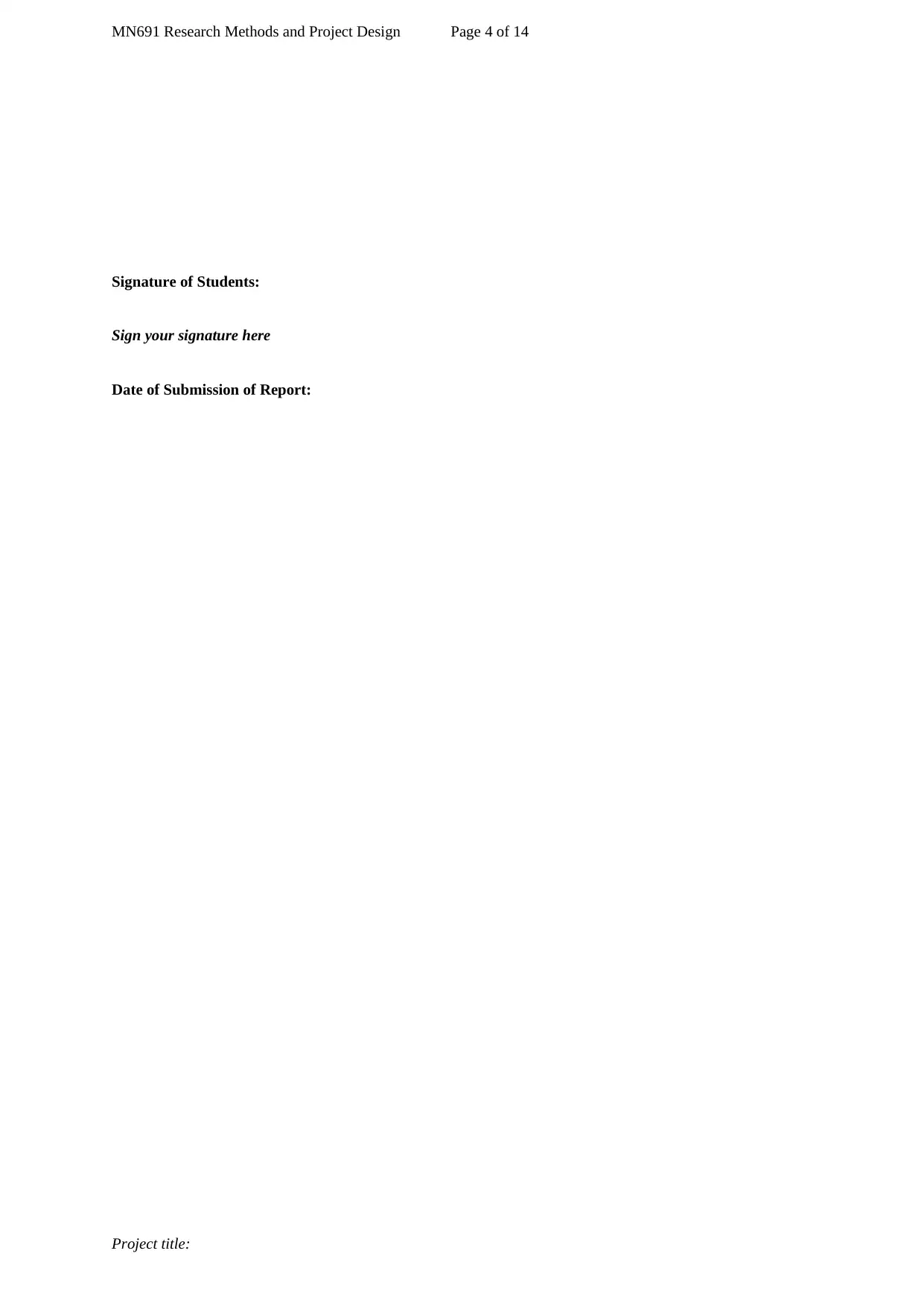
MN691 Research Methods and Project Design Page 4 of 14
Signature of Students:
Sign your signature here
Date of Submission of Report:
Project title:
Signature of Students:
Sign your signature here
Date of Submission of Report:
Project title:
Paraphrase This Document
Need a fresh take? Get an instant paraphrase of this document with our AI Paraphraser
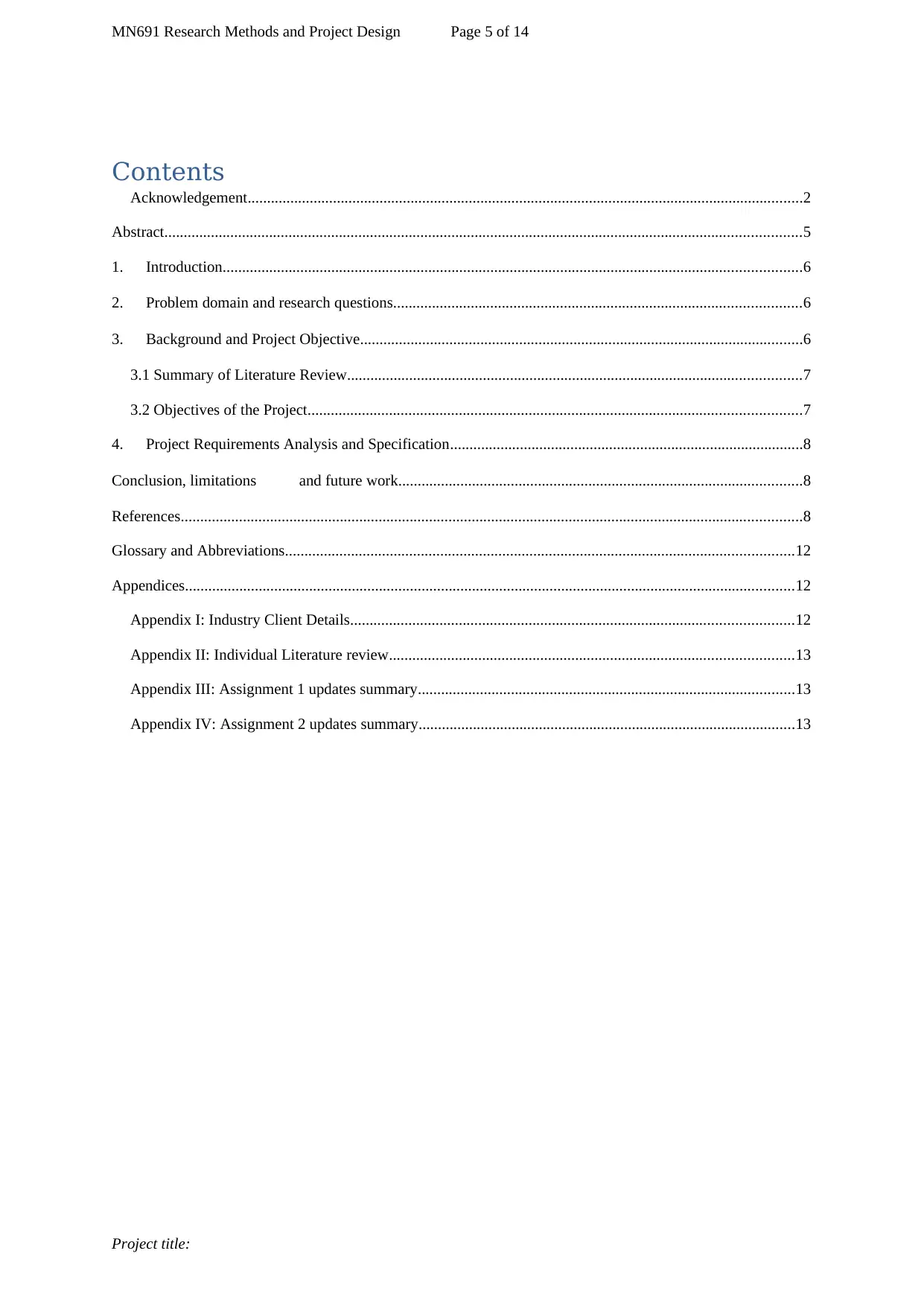
MN691 Research Methods and Project Design Page 5 of 14
Contents
Acknowledgement...............................................................................................................................................2
Abstract....................................................................................................................................................................5
1. Introduction.....................................................................................................................................................6
2. Problem domain and research questions.........................................................................................................6
3. Background and Project Objective..................................................................................................................6
3.1 Summary of Literature Review.....................................................................................................................7
3.2 Objectives of the Project...............................................................................................................................7
4. Project Requirements Analysis and Specification...........................................................................................8
Conclusion, limitations and future work........................................................................................................8
References................................................................................................................................................................8
Glossary and Abbreviations...................................................................................................................................12
Appendices.............................................................................................................................................................12
Appendix I: Industry Client Details..................................................................................................................12
Appendix II: Individual Literature review........................................................................................................13
Appendix III: Assignment 1 updates summary.................................................................................................13
Appendix IV: Assignment 2 updates summary.................................................................................................13
Project title:
Contents
Acknowledgement...............................................................................................................................................2
Abstract....................................................................................................................................................................5
1. Introduction.....................................................................................................................................................6
2. Problem domain and research questions.........................................................................................................6
3. Background and Project Objective..................................................................................................................6
3.1 Summary of Literature Review.....................................................................................................................7
3.2 Objectives of the Project...............................................................................................................................7
4. Project Requirements Analysis and Specification...........................................................................................8
Conclusion, limitations and future work........................................................................................................8
References................................................................................................................................................................8
Glossary and Abbreviations...................................................................................................................................12
Appendices.............................................................................................................................................................12
Appendix I: Industry Client Details..................................................................................................................12
Appendix II: Individual Literature review........................................................................................................13
Appendix III: Assignment 1 updates summary.................................................................................................13
Appendix IV: Assignment 2 updates summary.................................................................................................13
Project title:
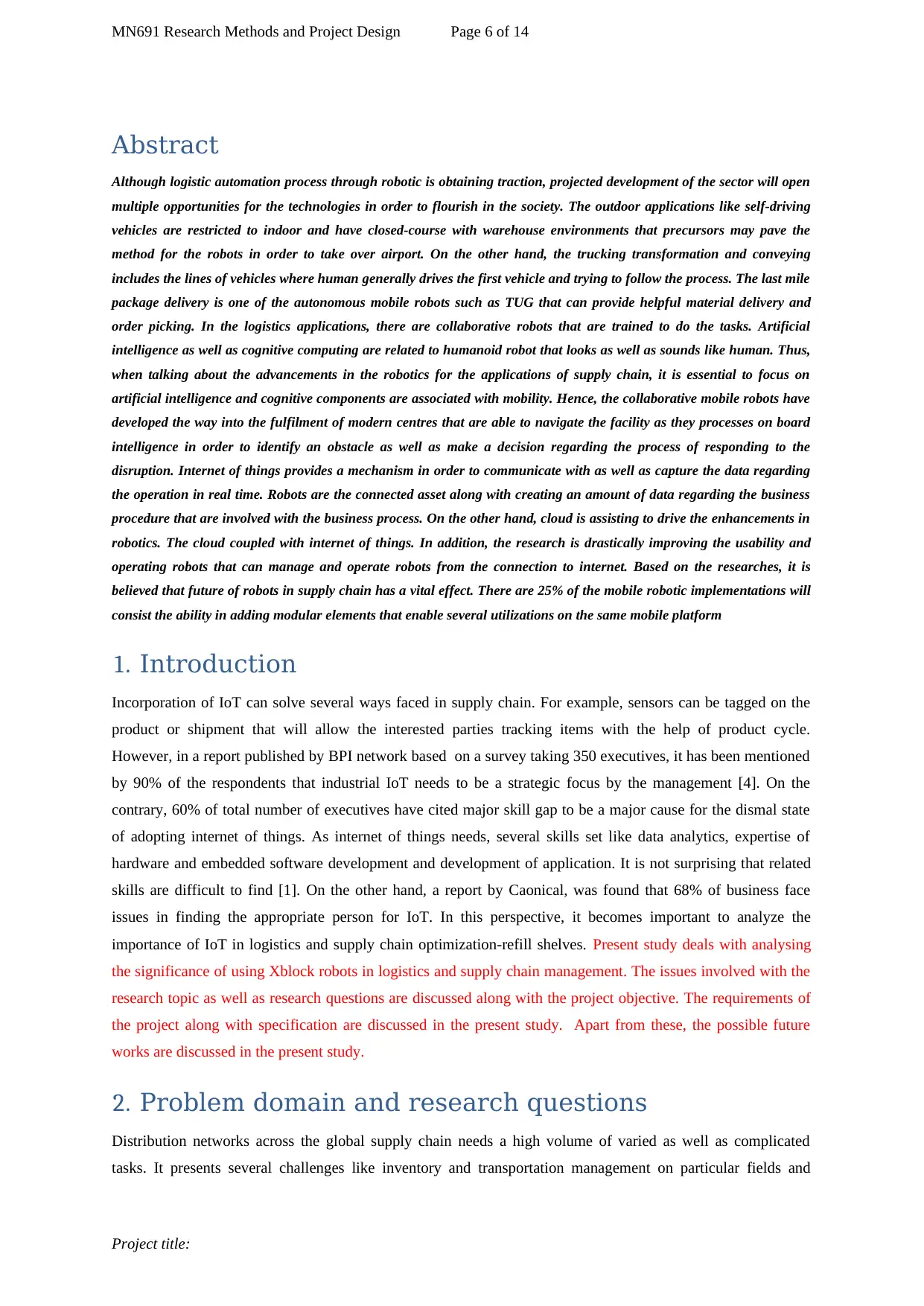
MN691 Research Methods and Project Design Page 6 of 14
Abstract
Although logistic automation process through robotic is obtaining traction, projected development of the sector will open
multiple opportunities for the technologies in order to flourish in the society. The outdoor applications like self-driving
vehicles are restricted to indoor and have closed-course with warehouse environments that precursors may pave the
method for the robots in order to take over airport. On the other hand, the trucking transformation and conveying
includes the lines of vehicles where human generally drives the first vehicle and trying to follow the process. The last mile
package delivery is one of the autonomous mobile robots such as TUG that can provide helpful material delivery and
order picking. In the logistics applications, there are collaborative robots that are trained to do the tasks. Artificial
intelligence as well as cognitive computing are related to humanoid robot that looks as well as sounds like human. Thus,
when talking about the advancements in the robotics for the applications of supply chain, it is essential to focus on
artificial intelligence and cognitive components are associated with mobility. Hence, the collaborative mobile robots have
developed the way into the fulfilment of modern centres that are able to navigate the facility as they processes on board
intelligence in order to identify an obstacle as well as make a decision regarding the process of responding to the
disruption. Internet of things provides a mechanism in order to communicate with as well as capture the data regarding
the operation in real time. Robots are the connected asset along with creating an amount of data regarding the business
procedure that are involved with the business process. On the other hand, cloud is assisting to drive the enhancements in
robotics. The cloud coupled with internet of things. In addition, the research is drastically improving the usability and
operating robots that can manage and operate robots from the connection to internet. Based on the researches, it is
believed that future of robots in supply chain has a vital effect. There are 25% of the mobile robotic implementations will
consist the ability in adding modular elements that enable several utilizations on the same mobile platform
1. Introduction
Incorporation of IoT can solve several ways faced in supply chain. For example, sensors can be tagged on the
product or shipment that will allow the interested parties tracking items with the help of product cycle.
However, in a report published by BPI network based on a survey taking 350 executives, it has been mentioned
by 90% of the respondents that industrial IoT needs to be a strategic focus by the management [4]. On the
contrary, 60% of total number of executives have cited major skill gap to be a major cause for the dismal state
of adopting internet of things. As internet of things needs, several skills set like data analytics, expertise of
hardware and embedded software development and development of application. It is not surprising that related
skills are difficult to find [1]. On the other hand, a report by Caonical, was found that 68% of business face
issues in finding the appropriate person for IoT. In this perspective, it becomes important to analyze the
importance of IoT in logistics and supply chain optimization-refill shelves. Present study deals with analysing
the significance of using Xblock robots in logistics and supply chain management. The issues involved with the
research topic as well as research questions are discussed along with the project objective. The requirements of
the project along with specification are discussed in the present study. Apart from these, the possible future
works are discussed in the present study.
2. Problem domain and research questions
Distribution networks across the global supply chain needs a high volume of varied as well as complicated
tasks. It presents several challenges like inventory and transportation management on particular fields and
Project title:
Abstract
Although logistic automation process through robotic is obtaining traction, projected development of the sector will open
multiple opportunities for the technologies in order to flourish in the society. The outdoor applications like self-driving
vehicles are restricted to indoor and have closed-course with warehouse environments that precursors may pave the
method for the robots in order to take over airport. On the other hand, the trucking transformation and conveying
includes the lines of vehicles where human generally drives the first vehicle and trying to follow the process. The last mile
package delivery is one of the autonomous mobile robots such as TUG that can provide helpful material delivery and
order picking. In the logistics applications, there are collaborative robots that are trained to do the tasks. Artificial
intelligence as well as cognitive computing are related to humanoid robot that looks as well as sounds like human. Thus,
when talking about the advancements in the robotics for the applications of supply chain, it is essential to focus on
artificial intelligence and cognitive components are associated with mobility. Hence, the collaborative mobile robots have
developed the way into the fulfilment of modern centres that are able to navigate the facility as they processes on board
intelligence in order to identify an obstacle as well as make a decision regarding the process of responding to the
disruption. Internet of things provides a mechanism in order to communicate with as well as capture the data regarding
the operation in real time. Robots are the connected asset along with creating an amount of data regarding the business
procedure that are involved with the business process. On the other hand, cloud is assisting to drive the enhancements in
robotics. The cloud coupled with internet of things. In addition, the research is drastically improving the usability and
operating robots that can manage and operate robots from the connection to internet. Based on the researches, it is
believed that future of robots in supply chain has a vital effect. There are 25% of the mobile robotic implementations will
consist the ability in adding modular elements that enable several utilizations on the same mobile platform
1. Introduction
Incorporation of IoT can solve several ways faced in supply chain. For example, sensors can be tagged on the
product or shipment that will allow the interested parties tracking items with the help of product cycle.
However, in a report published by BPI network based on a survey taking 350 executives, it has been mentioned
by 90% of the respondents that industrial IoT needs to be a strategic focus by the management [4]. On the
contrary, 60% of total number of executives have cited major skill gap to be a major cause for the dismal state
of adopting internet of things. As internet of things needs, several skills set like data analytics, expertise of
hardware and embedded software development and development of application. It is not surprising that related
skills are difficult to find [1]. On the other hand, a report by Caonical, was found that 68% of business face
issues in finding the appropriate person for IoT. In this perspective, it becomes important to analyze the
importance of IoT in logistics and supply chain optimization-refill shelves. Present study deals with analysing
the significance of using Xblock robots in logistics and supply chain management. The issues involved with the
research topic as well as research questions are discussed along with the project objective. The requirements of
the project along with specification are discussed in the present study. Apart from these, the possible future
works are discussed in the present study.
2. Problem domain and research questions
Distribution networks across the global supply chain needs a high volume of varied as well as complicated
tasks. It presents several challenges like inventory and transportation management on particular fields and
Project title:
⊘ This is a preview!⊘
Do you want full access?
Subscribe today to unlock all pages.

Trusted by 1+ million students worldwide
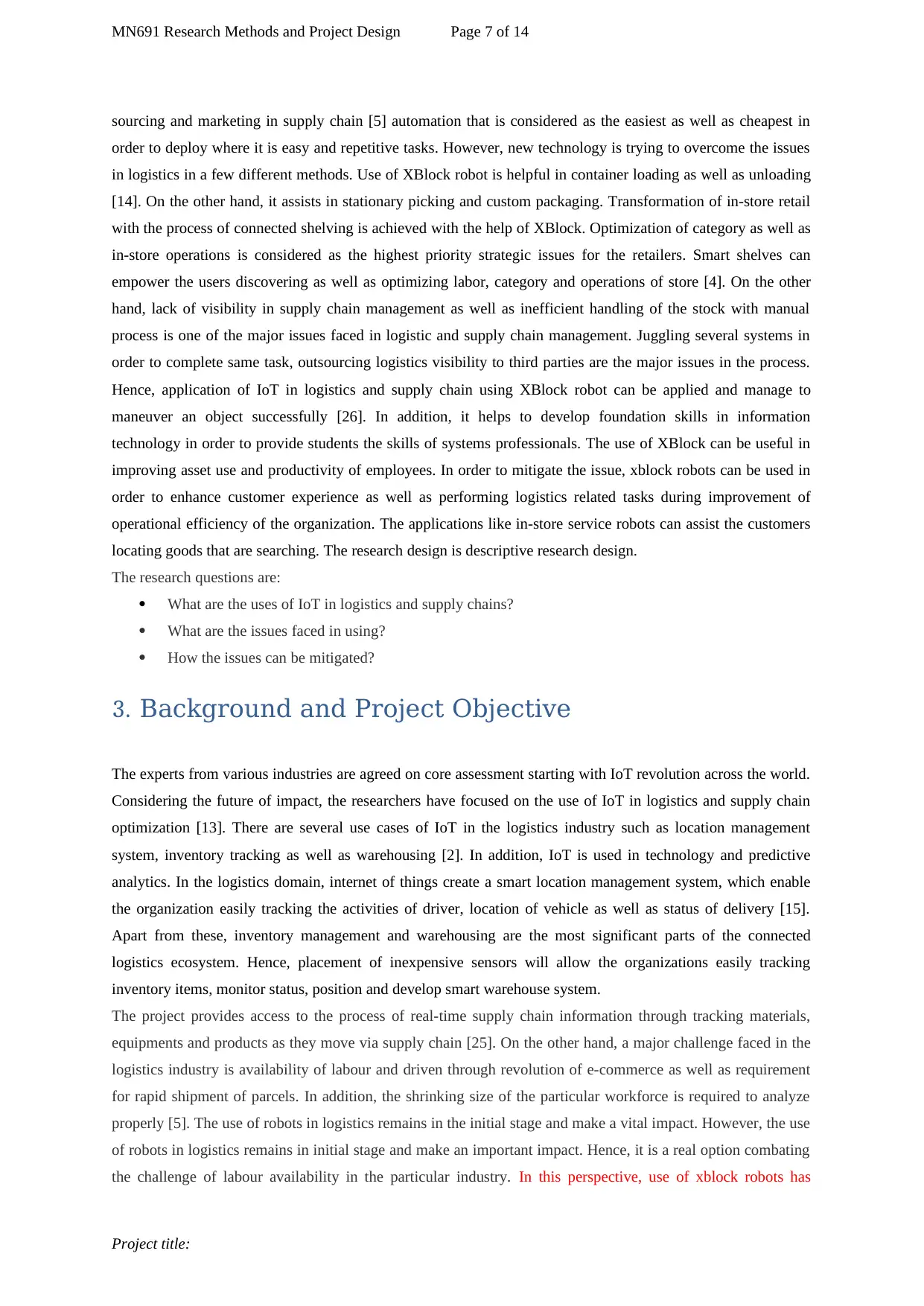
MN691 Research Methods and Project Design Page 7 of 14
sourcing and marketing in supply chain [5] automation that is considered as the easiest as well as cheapest in
order to deploy where it is easy and repetitive tasks. However, new technology is trying to overcome the issues
in logistics in a few different methods. Use of XBlock robot is helpful in container loading as well as unloading
[14]. On the other hand, it assists in stationary picking and custom packaging. Transformation of in-store retail
with the process of connected shelving is achieved with the help of XBlock. Optimization of category as well as
in-store operations is considered as the highest priority strategic issues for the retailers. Smart shelves can
empower the users discovering as well as optimizing labor, category and operations of store [4]. On the other
hand, lack of visibility in supply chain management as well as inefficient handling of the stock with manual
process is one of the major issues faced in logistic and supply chain management. Juggling several systems in
order to complete same task, outsourcing logistics visibility to third parties are the major issues in the process.
Hence, application of IoT in logistics and supply chain using XBlock robot can be applied and manage to
maneuver an object successfully [26]. In addition, it helps to develop foundation skills in information
technology in order to provide students the skills of systems professionals. The use of XBlock can be useful in
improving asset use and productivity of employees. In order to mitigate the issue, xblock robots can be used in
order to enhance customer experience as well as performing logistics related tasks during improvement of
operational efficiency of the organization. The applications like in-store service robots can assist the customers
locating goods that are searching. The research design is descriptive research design.
The research questions are:
What are the uses of IoT in logistics and supply chains?
What are the issues faced in using?
How the issues can be mitigated?
3. Background and Project Objective
The experts from various industries are agreed on core assessment starting with IoT revolution across the world.
Considering the future of impact, the researchers have focused on the use of IoT in logistics and supply chain
optimization [13]. There are several use cases of IoT in the logistics industry such as location management
system, inventory tracking as well as warehousing [2]. In addition, IoT is used in technology and predictive
analytics. In the logistics domain, internet of things create a smart location management system, which enable
the organization easily tracking the activities of driver, location of vehicle as well as status of delivery [15].
Apart from these, inventory management and warehousing are the most significant parts of the connected
logistics ecosystem. Hence, placement of inexpensive sensors will allow the organizations easily tracking
inventory items, monitor status, position and develop smart warehouse system.
The project provides access to the process of real-time supply chain information through tracking materials,
equipments and products as they move via supply chain [25]. On the other hand, a major challenge faced in the
logistics industry is availability of labour and driven through revolution of e-commerce as well as requirement
for rapid shipment of parcels. In addition, the shrinking size of the particular workforce is required to analyze
properly [5]. The use of robots in logistics remains in the initial stage and make a vital impact. However, the use
of robots in logistics remains in initial stage and make an important impact. Hence, it is a real option combating
the challenge of labour availability in the particular industry. In this perspective, use of xblock robots has
Project title:
sourcing and marketing in supply chain [5] automation that is considered as the easiest as well as cheapest in
order to deploy where it is easy and repetitive tasks. However, new technology is trying to overcome the issues
in logistics in a few different methods. Use of XBlock robot is helpful in container loading as well as unloading
[14]. On the other hand, it assists in stationary picking and custom packaging. Transformation of in-store retail
with the process of connected shelving is achieved with the help of XBlock. Optimization of category as well as
in-store operations is considered as the highest priority strategic issues for the retailers. Smart shelves can
empower the users discovering as well as optimizing labor, category and operations of store [4]. On the other
hand, lack of visibility in supply chain management as well as inefficient handling of the stock with manual
process is one of the major issues faced in logistic and supply chain management. Juggling several systems in
order to complete same task, outsourcing logistics visibility to third parties are the major issues in the process.
Hence, application of IoT in logistics and supply chain using XBlock robot can be applied and manage to
maneuver an object successfully [26]. In addition, it helps to develop foundation skills in information
technology in order to provide students the skills of systems professionals. The use of XBlock can be useful in
improving asset use and productivity of employees. In order to mitigate the issue, xblock robots can be used in
order to enhance customer experience as well as performing logistics related tasks during improvement of
operational efficiency of the organization. The applications like in-store service robots can assist the customers
locating goods that are searching. The research design is descriptive research design.
The research questions are:
What are the uses of IoT in logistics and supply chains?
What are the issues faced in using?
How the issues can be mitigated?
3. Background and Project Objective
The experts from various industries are agreed on core assessment starting with IoT revolution across the world.
Considering the future of impact, the researchers have focused on the use of IoT in logistics and supply chain
optimization [13]. There are several use cases of IoT in the logistics industry such as location management
system, inventory tracking as well as warehousing [2]. In addition, IoT is used in technology and predictive
analytics. In the logistics domain, internet of things create a smart location management system, which enable
the organization easily tracking the activities of driver, location of vehicle as well as status of delivery [15].
Apart from these, inventory management and warehousing are the most significant parts of the connected
logistics ecosystem. Hence, placement of inexpensive sensors will allow the organizations easily tracking
inventory items, monitor status, position and develop smart warehouse system.
The project provides access to the process of real-time supply chain information through tracking materials,
equipments and products as they move via supply chain [25]. On the other hand, a major challenge faced in the
logistics industry is availability of labour and driven through revolution of e-commerce as well as requirement
for rapid shipment of parcels. In addition, the shrinking size of the particular workforce is required to analyze
properly [5]. The use of robots in logistics remains in the initial stage and make a vital impact. However, the use
of robots in logistics remains in initial stage and make an important impact. Hence, it is a real option combating
the challenge of labour availability in the particular industry. In this perspective, use of xblock robots has
Project title:
Paraphrase This Document
Need a fresh take? Get an instant paraphrase of this document with our AI Paraphraser
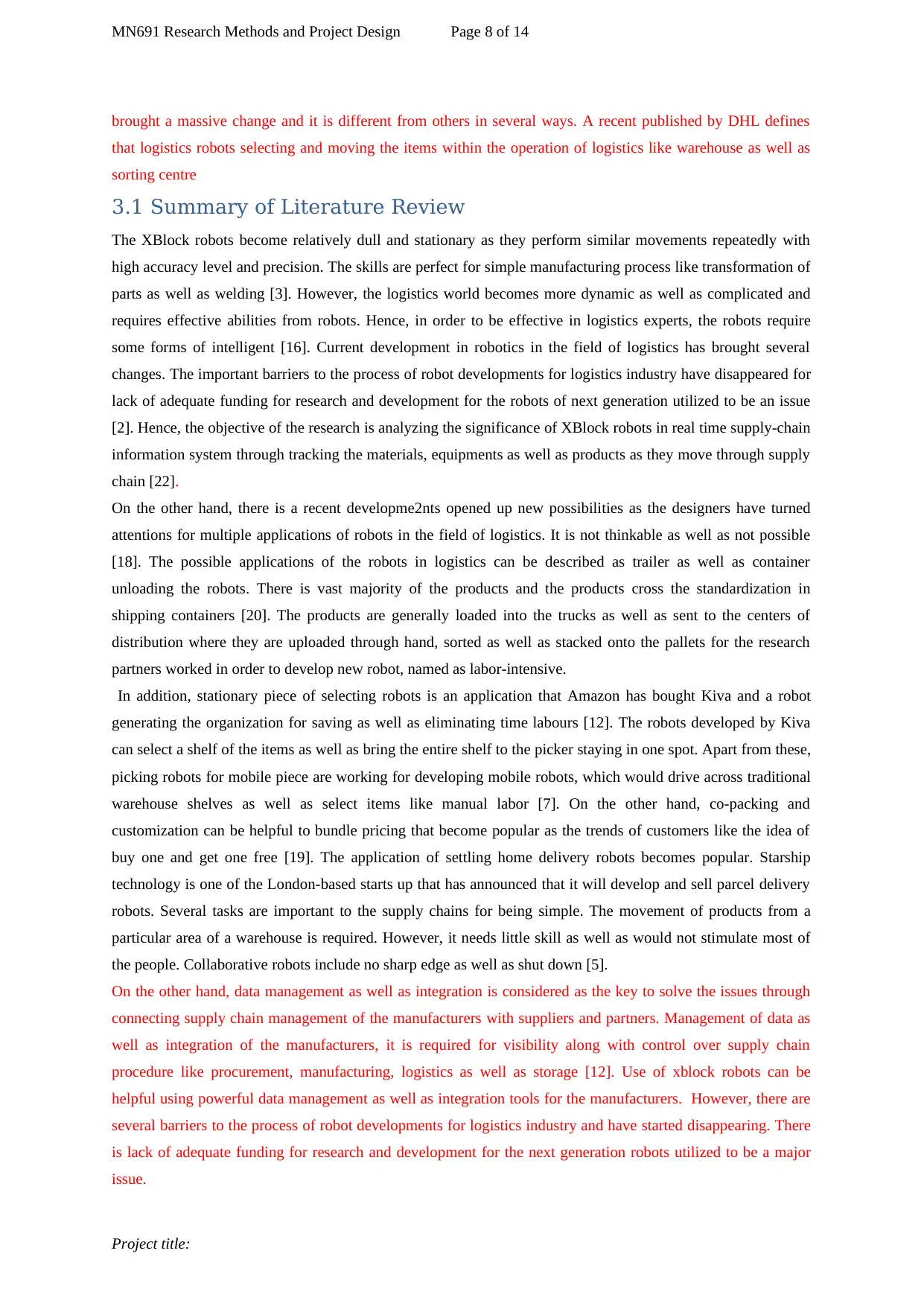
MN691 Research Methods and Project Design Page 8 of 14
brought a massive change and it is different from others in several ways. A recent published by DHL defines
that logistics robots selecting and moving the items within the operation of logistics like warehouse as well as
sorting centre
3.1 Summary of Literature Review
The XBlock robots become relatively dull and stationary as they perform similar movements repeatedly with
high accuracy level and precision. The skills are perfect for simple manufacturing process like transformation of
parts as well as welding [3]. However, the logistics world becomes more dynamic as well as complicated and
requires effective abilities from robots. Hence, in order to be effective in logistics experts, the robots require
some forms of intelligent [16]. Current development in robotics in the field of logistics has brought several
changes. The important barriers to the process of robot developments for logistics industry have disappeared for
lack of adequate funding for research and development for the robots of next generation utilized to be an issue
[2]. Hence, the objective of the research is analyzing the significance of XBlock robots in real time supply-chain
information system through tracking the materials, equipments as well as products as they move through supply
chain [22].
On the other hand, there is a recent developme2nts opened up new possibilities as the designers have turned
attentions for multiple applications of robots in the field of logistics. It is not thinkable as well as not possible
[18]. The possible applications of the robots in logistics can be described as trailer as well as container
unloading the robots. There is vast majority of the products and the products cross the standardization in
shipping containers [20]. The products are generally loaded into the trucks as well as sent to the centers of
distribution where they are uploaded through hand, sorted as well as stacked onto the pallets for the research
partners worked in order to develop new robot, named as labor-intensive.
In addition, stationary piece of selecting robots is an application that Amazon has bought Kiva and a robot
generating the organization for saving as well as eliminating time labours [12]. The robots developed by Kiva
can select a shelf of the items as well as bring the entire shelf to the picker staying in one spot. Apart from these,
picking robots for mobile piece are working for developing mobile robots, which would drive across traditional
warehouse shelves as well as select items like manual labor [7]. On the other hand, co-packing and
customization can be helpful to bundle pricing that become popular as the trends of customers like the idea of
buy one and get one free [19]. The application of settling home delivery robots becomes popular. Starship
technology is one of the London-based starts up that has announced that it will develop and sell parcel delivery
robots. Several tasks are important to the supply chains for being simple. The movement of products from a
particular area of a warehouse is required. However, it needs little skill as well as would not stimulate most of
the people. Collaborative robots include no sharp edge as well as shut down [5].
On the other hand, data management as well as integration is considered as the key to solve the issues through
connecting supply chain management of the manufacturers with suppliers and partners. Management of data as
well as integration of the manufacturers, it is required for visibility along with control over supply chain
procedure like procurement, manufacturing, logistics as well as storage [12]. Use of xblock robots can be
helpful using powerful data management as well as integration tools for the manufacturers. However, there are
several barriers to the process of robot developments for logistics industry and have started disappearing. There
is lack of adequate funding for research and development for the next generation robots utilized to be a major
issue.
Project title:
brought a massive change and it is different from others in several ways. A recent published by DHL defines
that logistics robots selecting and moving the items within the operation of logistics like warehouse as well as
sorting centre
3.1 Summary of Literature Review
The XBlock robots become relatively dull and stationary as they perform similar movements repeatedly with
high accuracy level and precision. The skills are perfect for simple manufacturing process like transformation of
parts as well as welding [3]. However, the logistics world becomes more dynamic as well as complicated and
requires effective abilities from robots. Hence, in order to be effective in logistics experts, the robots require
some forms of intelligent [16]. Current development in robotics in the field of logistics has brought several
changes. The important barriers to the process of robot developments for logistics industry have disappeared for
lack of adequate funding for research and development for the robots of next generation utilized to be an issue
[2]. Hence, the objective of the research is analyzing the significance of XBlock robots in real time supply-chain
information system through tracking the materials, equipments as well as products as they move through supply
chain [22].
On the other hand, there is a recent developme2nts opened up new possibilities as the designers have turned
attentions for multiple applications of robots in the field of logistics. It is not thinkable as well as not possible
[18]. The possible applications of the robots in logistics can be described as trailer as well as container
unloading the robots. There is vast majority of the products and the products cross the standardization in
shipping containers [20]. The products are generally loaded into the trucks as well as sent to the centers of
distribution where they are uploaded through hand, sorted as well as stacked onto the pallets for the research
partners worked in order to develop new robot, named as labor-intensive.
In addition, stationary piece of selecting robots is an application that Amazon has bought Kiva and a robot
generating the organization for saving as well as eliminating time labours [12]. The robots developed by Kiva
can select a shelf of the items as well as bring the entire shelf to the picker staying in one spot. Apart from these,
picking robots for mobile piece are working for developing mobile robots, which would drive across traditional
warehouse shelves as well as select items like manual labor [7]. On the other hand, co-packing and
customization can be helpful to bundle pricing that become popular as the trends of customers like the idea of
buy one and get one free [19]. The application of settling home delivery robots becomes popular. Starship
technology is one of the London-based starts up that has announced that it will develop and sell parcel delivery
robots. Several tasks are important to the supply chains for being simple. The movement of products from a
particular area of a warehouse is required. However, it needs little skill as well as would not stimulate most of
the people. Collaborative robots include no sharp edge as well as shut down [5].
On the other hand, data management as well as integration is considered as the key to solve the issues through
connecting supply chain management of the manufacturers with suppliers and partners. Management of data as
well as integration of the manufacturers, it is required for visibility along with control over supply chain
procedure like procurement, manufacturing, logistics as well as storage [12]. Use of xblock robots can be
helpful using powerful data management as well as integration tools for the manufacturers. However, there are
several barriers to the process of robot developments for logistics industry and have started disappearing. There
is lack of adequate funding for research and development for the next generation robots utilized to be a major
issue.
Project title:
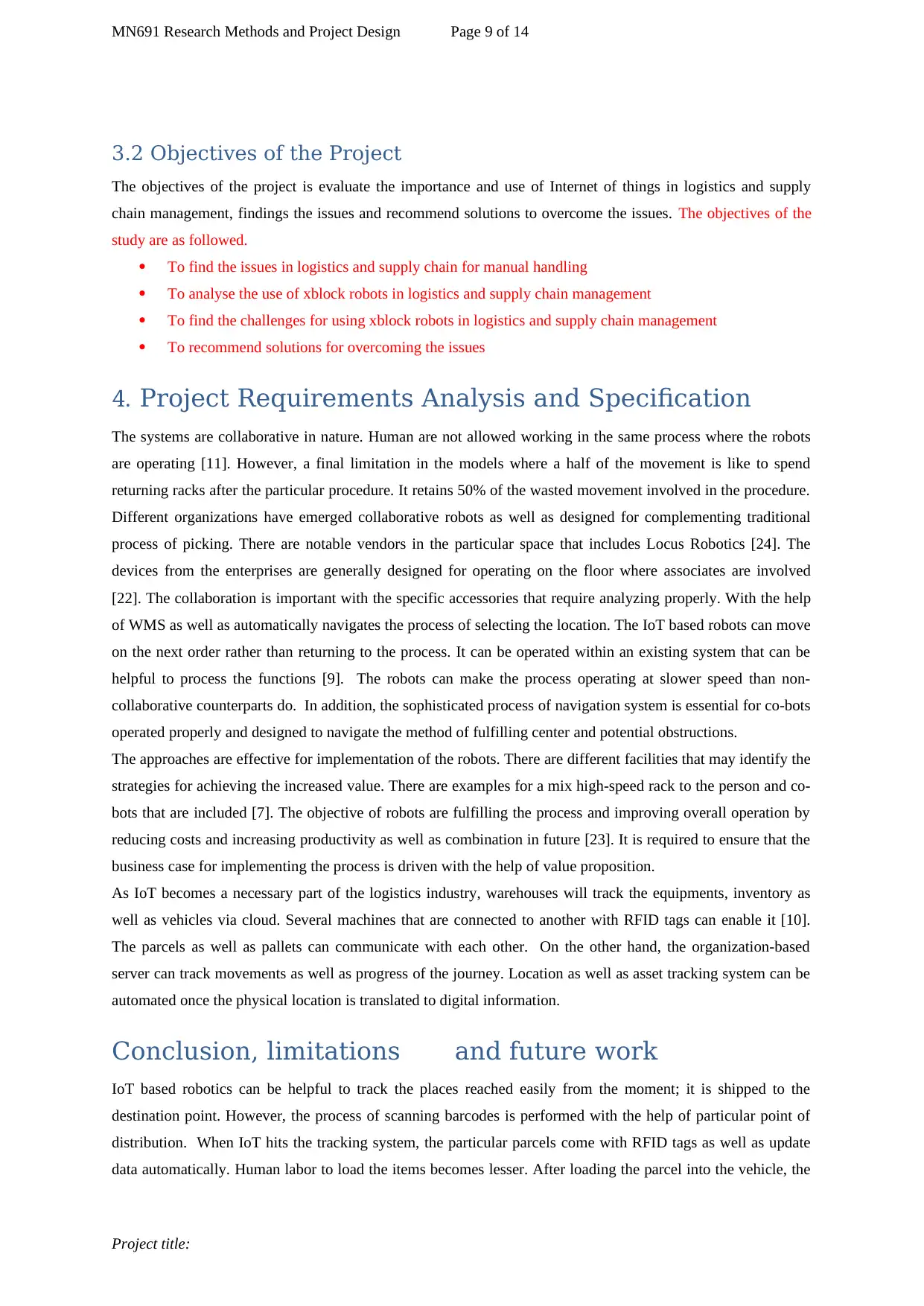
MN691 Research Methods and Project Design Page 9 of 14
3.2 Objectives of the Project
The objectives of the project is evaluate the importance and use of Internet of things in logistics and supply
chain management, findings the issues and recommend solutions to overcome the issues. The objectives of the
study are as followed.
To find the issues in logistics and supply chain for manual handling
To analyse the use of xblock robots in logistics and supply chain management
To find the challenges for using xblock robots in logistics and supply chain management
To recommend solutions for overcoming the issues
4. Project Requirements Analysis and Specification
The systems are collaborative in nature. Human are not allowed working in the same process where the robots
are operating [11]. However, a final limitation in the models where a half of the movement is like to spend
returning racks after the particular procedure. It retains 50% of the wasted movement involved in the procedure.
Different organizations have emerged collaborative robots as well as designed for complementing traditional
process of picking. There are notable vendors in the particular space that includes Locus Robotics [24]. The
devices from the enterprises are generally designed for operating on the floor where associates are involved
[22]. The collaboration is important with the specific accessories that require analyzing properly. With the help
of WMS as well as automatically navigates the process of selecting the location. The IoT based robots can move
on the next order rather than returning to the process. It can be operated within an existing system that can be
helpful to process the functions [9]. The robots can make the process operating at slower speed than non-
collaborative counterparts do. In addition, the sophisticated process of navigation system is essential for co-bots
operated properly and designed to navigate the method of fulfilling center and potential obstructions.
The approaches are effective for implementation of the robots. There are different facilities that may identify the
strategies for achieving the increased value. There are examples for a mix high-speed rack to the person and co-
bots that are included [7]. The objective of robots are fulfilling the process and improving overall operation by
reducing costs and increasing productivity as well as combination in future [23]. It is required to ensure that the
business case for implementing the process is driven with the help of value proposition.
As IoT becomes a necessary part of the logistics industry, warehouses will track the equipments, inventory as
well as vehicles via cloud. Several machines that are connected to another with RFID tags can enable it [10].
The parcels as well as pallets can communicate with each other. On the other hand, the organization-based
server can track movements as well as progress of the journey. Location as well as asset tracking system can be
automated once the physical location is translated to digital information.
Conclusion, limitations and future work
IoT based robotics can be helpful to track the places reached easily from the moment; it is shipped to the
destination point. However, the process of scanning barcodes is performed with the help of particular point of
distribution. When IoT hits the tracking system, the particular parcels come with RFID tags as well as update
data automatically. Human labor to load the items becomes lesser. After loading the parcel into the vehicle, the
Project title:
3.2 Objectives of the Project
The objectives of the project is evaluate the importance and use of Internet of things in logistics and supply
chain management, findings the issues and recommend solutions to overcome the issues. The objectives of the
study are as followed.
To find the issues in logistics and supply chain for manual handling
To analyse the use of xblock robots in logistics and supply chain management
To find the challenges for using xblock robots in logistics and supply chain management
To recommend solutions for overcoming the issues
4. Project Requirements Analysis and Specification
The systems are collaborative in nature. Human are not allowed working in the same process where the robots
are operating [11]. However, a final limitation in the models where a half of the movement is like to spend
returning racks after the particular procedure. It retains 50% of the wasted movement involved in the procedure.
Different organizations have emerged collaborative robots as well as designed for complementing traditional
process of picking. There are notable vendors in the particular space that includes Locus Robotics [24]. The
devices from the enterprises are generally designed for operating on the floor where associates are involved
[22]. The collaboration is important with the specific accessories that require analyzing properly. With the help
of WMS as well as automatically navigates the process of selecting the location. The IoT based robots can move
on the next order rather than returning to the process. It can be operated within an existing system that can be
helpful to process the functions [9]. The robots can make the process operating at slower speed than non-
collaborative counterparts do. In addition, the sophisticated process of navigation system is essential for co-bots
operated properly and designed to navigate the method of fulfilling center and potential obstructions.
The approaches are effective for implementation of the robots. There are different facilities that may identify the
strategies for achieving the increased value. There are examples for a mix high-speed rack to the person and co-
bots that are included [7]. The objective of robots are fulfilling the process and improving overall operation by
reducing costs and increasing productivity as well as combination in future [23]. It is required to ensure that the
business case for implementing the process is driven with the help of value proposition.
As IoT becomes a necessary part of the logistics industry, warehouses will track the equipments, inventory as
well as vehicles via cloud. Several machines that are connected to another with RFID tags can enable it [10].
The parcels as well as pallets can communicate with each other. On the other hand, the organization-based
server can track movements as well as progress of the journey. Location as well as asset tracking system can be
automated once the physical location is translated to digital information.
Conclusion, limitations and future work
IoT based robotics can be helpful to track the places reached easily from the moment; it is shipped to the
destination point. However, the process of scanning barcodes is performed with the help of particular point of
distribution. When IoT hits the tracking system, the particular parcels come with RFID tags as well as update
data automatically. Human labor to load the items becomes lesser. After loading the parcel into the vehicle, the
Project title:
⊘ This is a preview!⊘
Do you want full access?
Subscribe today to unlock all pages.

Trusted by 1+ million students worldwide
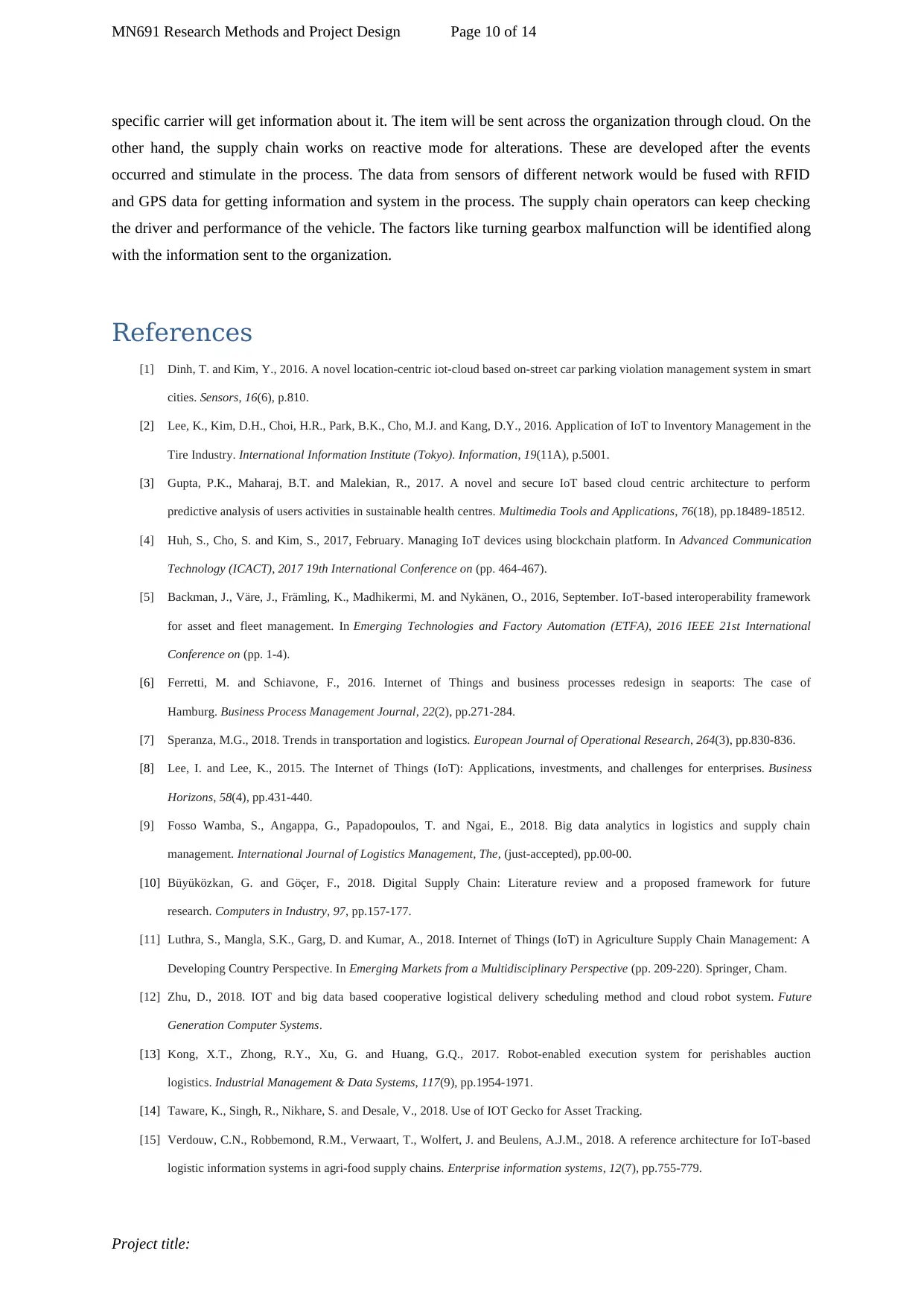
MN691 Research Methods and Project Design Page 10 of 14
specific carrier will get information about it. The item will be sent across the organization through cloud. On the
other hand, the supply chain works on reactive mode for alterations. These are developed after the events
occurred and stimulate in the process. The data from sensors of different network would be fused with RFID
and GPS data for getting information and system in the process. The supply chain operators can keep checking
the driver and performance of the vehicle. The factors like turning gearbox malfunction will be identified along
with the information sent to the organization.
References
[1] Dinh, T. and Kim, Y., 2016. A novel location-centric iot-cloud based on-street car parking violation management system in smart
cities. Sensors, 16(6), p.810.
[2] Lee, K., Kim, D.H., Choi, H.R., Park, B.K., Cho, M.J. and Kang, D.Y., 2016. Application of IoT to Inventory Management in the
Tire Industry. International Information Institute (Tokyo). Information, 19(11A), p.5001.
[3] Gupta, P.K., Maharaj, B.T. and Malekian, R., 2017. A novel and secure IoT based cloud centric architecture to perform
predictive analysis of users activities in sustainable health centres. Multimedia Tools and Applications, 76(18), pp.18489-18512.
[4] Huh, S., Cho, S. and Kim, S., 2017, February. Managing IoT devices using blockchain platform. In Advanced Communication
Technology (ICACT), 2017 19th International Conference on (pp. 464-467).
[5] Backman, J., Väre, J., Främling, K., Madhikermi, M. and Nykänen, O., 2016, September. IoT-based interoperability framework
for asset and fleet management. In Emerging Technologies and Factory Automation (ETFA), 2016 IEEE 21st International
Conference on (pp. 1-4).
[6] Ferretti, M. and Schiavone, F., 2016. Internet of Things and business processes redesign in seaports: The case of
Hamburg. Business Process Management Journal, 22(2), pp.271-284.
[7] Speranza, M.G., 2018. Trends in transportation and logistics. European Journal of Operational Research, 264(3), pp.830-836.
[8] Lee, I. and Lee, K., 2015. The Internet of Things (IoT): Applications, investments, and challenges for enterprises. Business
Horizons, 58(4), pp.431-440.
[9] Fosso Wamba, S., Angappa, G., Papadopoulos, T. and Ngai, E., 2018. Big data analytics in logistics and supply chain
management. International Journal of Logistics Management, The, (just-accepted), pp.00-00.
[10] Büyüközkan, G. and Göçer, F., 2018. Digital Supply Chain: Literature review and a proposed framework for future
research. Computers in Industry, 97, pp.157-177.
[11] Luthra, S., Mangla, S.K., Garg, D. and Kumar, A., 2018. Internet of Things (IoT) in Agriculture Supply Chain Management: A
Developing Country Perspective. In Emerging Markets from a Multidisciplinary Perspective (pp. 209-220). Springer, Cham.
[12] Zhu, D., 2018. IOT and big data based cooperative logistical delivery scheduling method and cloud robot system. Future
Generation Computer Systems.
[13] Kong, X.T., Zhong, R.Y., Xu, G. and Huang, G.Q., 2017. Robot-enabled execution system for perishables auction
logistics. Industrial Management & Data Systems, 117(9), pp.1954-1971.
[14] Taware, K., Singh, R., Nikhare, S. and Desale, V., 2018. Use of IOT Gecko for Asset Tracking.
[15] Verdouw, C.N., Robbemond, R.M., Verwaart, T., Wolfert, J. and Beulens, A.J.M., 2018. A reference architecture for IoT-based
logistic information systems in agri-food supply chains. Enterprise information systems, 12(7), pp.755-779.
Project title:
specific carrier will get information about it. The item will be sent across the organization through cloud. On the
other hand, the supply chain works on reactive mode for alterations. These are developed after the events
occurred and stimulate in the process. The data from sensors of different network would be fused with RFID
and GPS data for getting information and system in the process. The supply chain operators can keep checking
the driver and performance of the vehicle. The factors like turning gearbox malfunction will be identified along
with the information sent to the organization.
References
[1] Dinh, T. and Kim, Y., 2016. A novel location-centric iot-cloud based on-street car parking violation management system in smart
cities. Sensors, 16(6), p.810.
[2] Lee, K., Kim, D.H., Choi, H.R., Park, B.K., Cho, M.J. and Kang, D.Y., 2016. Application of IoT to Inventory Management in the
Tire Industry. International Information Institute (Tokyo). Information, 19(11A), p.5001.
[3] Gupta, P.K., Maharaj, B.T. and Malekian, R., 2017. A novel and secure IoT based cloud centric architecture to perform
predictive analysis of users activities in sustainable health centres. Multimedia Tools and Applications, 76(18), pp.18489-18512.
[4] Huh, S., Cho, S. and Kim, S., 2017, February. Managing IoT devices using blockchain platform. In Advanced Communication
Technology (ICACT), 2017 19th International Conference on (pp. 464-467).
[5] Backman, J., Väre, J., Främling, K., Madhikermi, M. and Nykänen, O., 2016, September. IoT-based interoperability framework
for asset and fleet management. In Emerging Technologies and Factory Automation (ETFA), 2016 IEEE 21st International
Conference on (pp. 1-4).
[6] Ferretti, M. and Schiavone, F., 2016. Internet of Things and business processes redesign in seaports: The case of
Hamburg. Business Process Management Journal, 22(2), pp.271-284.
[7] Speranza, M.G., 2018. Trends in transportation and logistics. European Journal of Operational Research, 264(3), pp.830-836.
[8] Lee, I. and Lee, K., 2015. The Internet of Things (IoT): Applications, investments, and challenges for enterprises. Business
Horizons, 58(4), pp.431-440.
[9] Fosso Wamba, S., Angappa, G., Papadopoulos, T. and Ngai, E., 2018. Big data analytics in logistics and supply chain
management. International Journal of Logistics Management, The, (just-accepted), pp.00-00.
[10] Büyüközkan, G. and Göçer, F., 2018. Digital Supply Chain: Literature review and a proposed framework for future
research. Computers in Industry, 97, pp.157-177.
[11] Luthra, S., Mangla, S.K., Garg, D. and Kumar, A., 2018. Internet of Things (IoT) in Agriculture Supply Chain Management: A
Developing Country Perspective. In Emerging Markets from a Multidisciplinary Perspective (pp. 209-220). Springer, Cham.
[12] Zhu, D., 2018. IOT and big data based cooperative logistical delivery scheduling method and cloud robot system. Future
Generation Computer Systems.
[13] Kong, X.T., Zhong, R.Y., Xu, G. and Huang, G.Q., 2017. Robot-enabled execution system for perishables auction
logistics. Industrial Management & Data Systems, 117(9), pp.1954-1971.
[14] Taware, K., Singh, R., Nikhare, S. and Desale, V., 2018. Use of IOT Gecko for Asset Tracking.
[15] Verdouw, C.N., Robbemond, R.M., Verwaart, T., Wolfert, J. and Beulens, A.J.M., 2018. A reference architecture for IoT-based
logistic information systems in agri-food supply chains. Enterprise information systems, 12(7), pp.755-779.
Project title:
Paraphrase This Document
Need a fresh take? Get an instant paraphrase of this document with our AI Paraphraser
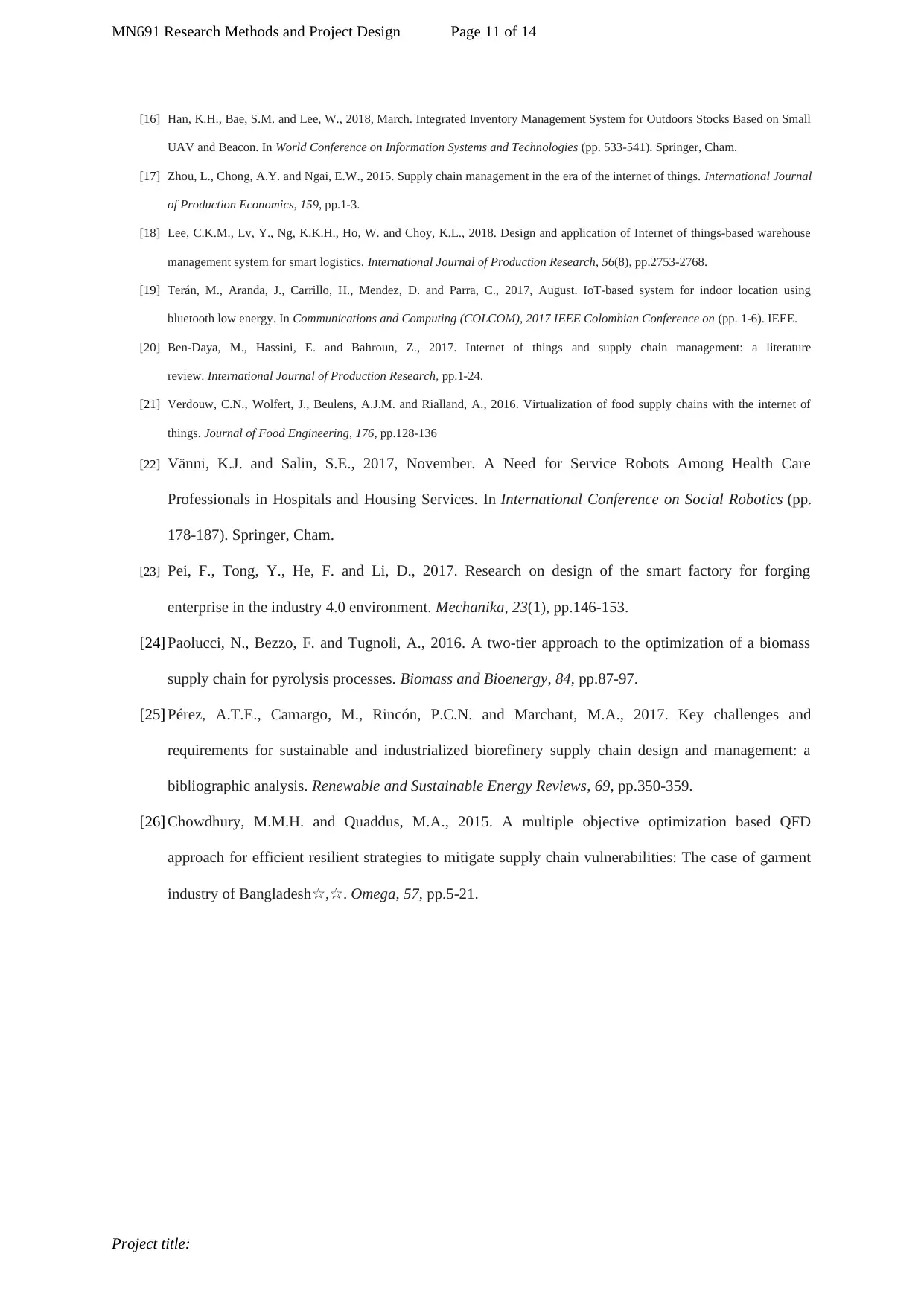
MN691 Research Methods and Project Design Page 11 of 14
[16] Han, K.H., Bae, S.M. and Lee, W., 2018, March. Integrated Inventory Management System for Outdoors Stocks Based on Small
UAV and Beacon. In World Conference on Information Systems and Technologies (pp. 533-541). Springer, Cham.
[17] Zhou, L., Chong, A.Y. and Ngai, E.W., 2015. Supply chain management in the era of the internet of things. International Journal
of Production Economics, 159, pp.1-3.
[18] Lee, C.K.M., Lv, Y., Ng, K.K.H., Ho, W. and Choy, K.L., 2018. Design and application of Internet of things-based warehouse
management system for smart logistics. International Journal of Production Research, 56(8), pp.2753-2768.
[19] Terán, M., Aranda, J., Carrillo, H., Mendez, D. and Parra, C., 2017, August. IoT-based system for indoor location using
bluetooth low energy. In Communications and Computing (COLCOM), 2017 IEEE Colombian Conference on (pp. 1-6). IEEE.
[20] Ben-Daya, M., Hassini, E. and Bahroun, Z., 2017. Internet of things and supply chain management: a literature
review. International Journal of Production Research, pp.1-24.
[21] Verdouw, C.N., Wolfert, J., Beulens, A.J.M. and Rialland, A., 2016. Virtualization of food supply chains with the internet of
things. Journal of Food Engineering, 176, pp.128-136
[22] Vänni, K.J. and Salin, S.E., 2017, November. A Need for Service Robots Among Health Care
Professionals in Hospitals and Housing Services. In International Conference on Social Robotics (pp.
178-187). Springer, Cham.
[23] Pei, F., Tong, Y., He, F. and Li, D., 2017. Research on design of the smart factory for forging
enterprise in the industry 4.0 environment. Mechanika, 23(1), pp.146-153.
[24] Paolucci, N., Bezzo, F. and Tugnoli, A., 2016. A two-tier approach to the optimization of a biomass
supply chain for pyrolysis processes. Biomass and Bioenergy, 84, pp.87-97.
[25] Pérez, A.T.E., Camargo, M., Rincón, P.C.N. and Marchant, M.A., 2017. Key challenges and
requirements for sustainable and industrialized biorefinery supply chain design and management: a
bibliographic analysis. Renewable and Sustainable Energy Reviews, 69, pp.350-359.
[26] Chowdhury, M.M.H. and Quaddus, M.A., 2015. A multiple objective optimization based QFD
approach for efficient resilient strategies to mitigate supply chain vulnerabilities: The case of garment
industry of Bangladesh☆,☆. Omega, 57, pp.5-21.
Project title:
[16] Han, K.H., Bae, S.M. and Lee, W., 2018, March. Integrated Inventory Management System for Outdoors Stocks Based on Small
UAV and Beacon. In World Conference on Information Systems and Technologies (pp. 533-541). Springer, Cham.
[17] Zhou, L., Chong, A.Y. and Ngai, E.W., 2015. Supply chain management in the era of the internet of things. International Journal
of Production Economics, 159, pp.1-3.
[18] Lee, C.K.M., Lv, Y., Ng, K.K.H., Ho, W. and Choy, K.L., 2018. Design and application of Internet of things-based warehouse
management system for smart logistics. International Journal of Production Research, 56(8), pp.2753-2768.
[19] Terán, M., Aranda, J., Carrillo, H., Mendez, D. and Parra, C., 2017, August. IoT-based system for indoor location using
bluetooth low energy. In Communications and Computing (COLCOM), 2017 IEEE Colombian Conference on (pp. 1-6). IEEE.
[20] Ben-Daya, M., Hassini, E. and Bahroun, Z., 2017. Internet of things and supply chain management: a literature
review. International Journal of Production Research, pp.1-24.
[21] Verdouw, C.N., Wolfert, J., Beulens, A.J.M. and Rialland, A., 2016. Virtualization of food supply chains with the internet of
things. Journal of Food Engineering, 176, pp.128-136
[22] Vänni, K.J. and Salin, S.E., 2017, November. A Need for Service Robots Among Health Care
Professionals in Hospitals and Housing Services. In International Conference on Social Robotics (pp.
178-187). Springer, Cham.
[23] Pei, F., Tong, Y., He, F. and Li, D., 2017. Research on design of the smart factory for forging
enterprise in the industry 4.0 environment. Mechanika, 23(1), pp.146-153.
[24] Paolucci, N., Bezzo, F. and Tugnoli, A., 2016. A two-tier approach to the optimization of a biomass
supply chain for pyrolysis processes. Biomass and Bioenergy, 84, pp.87-97.
[25] Pérez, A.T.E., Camargo, M., Rincón, P.C.N. and Marchant, M.A., 2017. Key challenges and
requirements for sustainable and industrialized biorefinery supply chain design and management: a
bibliographic analysis. Renewable and Sustainable Energy Reviews, 69, pp.350-359.
[26] Chowdhury, M.M.H. and Quaddus, M.A., 2015. A multiple objective optimization based QFD
approach for efficient resilient strategies to mitigate supply chain vulnerabilities: The case of garment
industry of Bangladesh☆,☆. Omega, 57, pp.5-21.
Project title:
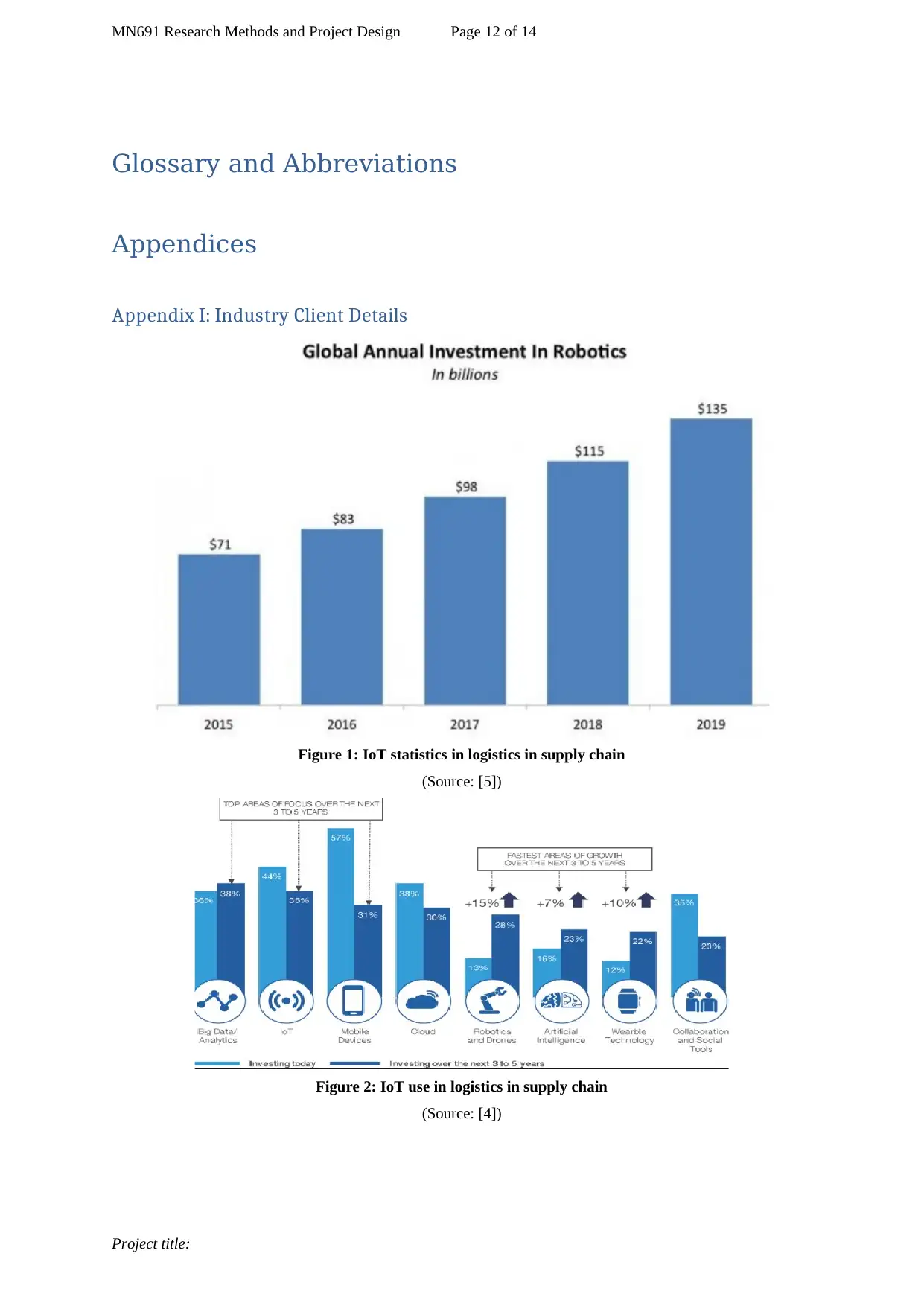
MN691 Research Methods and Project Design Page 12 of 14
Glossary and Abbreviations
Appendices
Appendix I: Industry Client Details
Figure 1: IoT statistics in logistics in supply chain
(Source: [5])
Figure 2: IoT use in logistics in supply chain
(Source: [4])
Project title:
Glossary and Abbreviations
Appendices
Appendix I: Industry Client Details
Figure 1: IoT statistics in logistics in supply chain
(Source: [5])
Figure 2: IoT use in logistics in supply chain
(Source: [4])
Project title:
⊘ This is a preview!⊘
Do you want full access?
Subscribe today to unlock all pages.

Trusted by 1+ million students worldwide
1 out of 14
Related Documents
Your All-in-One AI-Powered Toolkit for Academic Success.
+13062052269
info@desklib.com
Available 24*7 on WhatsApp / Email
![[object Object]](/_next/static/media/star-bottom.7253800d.svg)
Unlock your academic potential
Copyright © 2020–2025 A2Z Services. All Rights Reserved. Developed and managed by ZUCOL.





